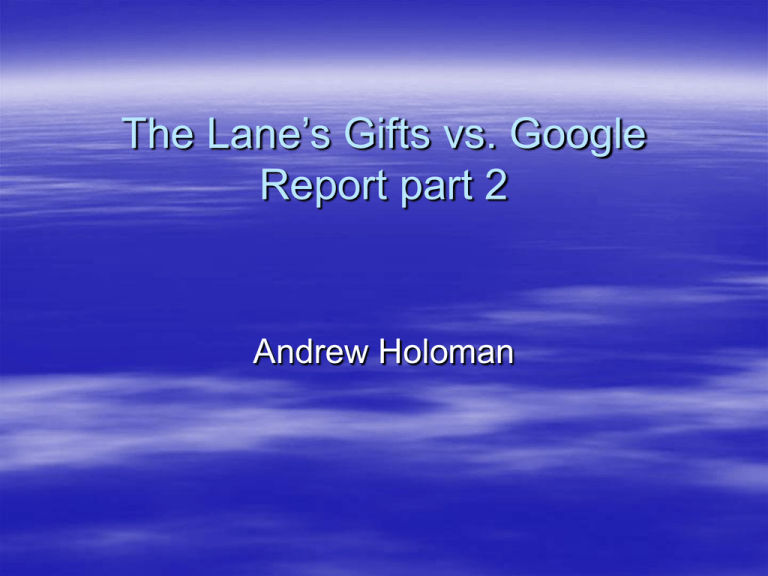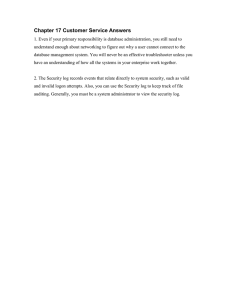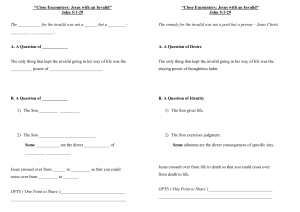The Lane’s Gifts vs. Google Report part 2 Andrew Holoman
advertisement

The Lane’s Gifts vs. Google Report part 2 Andrew Holoman Google’s Approach to Detecting Invalid Clicks Google’s Click Quality Team’s Mission Statement states: Protect Google’s advertising network and provide excellent customer service to clients by: – Vigilantly monitoring invalid clicks/impressions and removing its source – Reviewing all client requests and responding in a timely manner – Developing and improving systems that remove invalid clicks/impressions and properly credit clients for invalid traffic – Educating clients and employees on invalid clicks/impressions The Click Quality Team practices this by raising the levels of click fraud detection methods where it becomes hard and unrewarding to commit click fraud against Google Strategic Objectives Google tries to achieve these objectives in two ways: – Prevention Discouraging invalid clicking activities on its Network by making life of unethical users more difficult and less rewarding – Detection Detecting and removing invalid clicks and the perpetrators Preventive Measures Google tries to build mechanisms for preventing invalid clicking that reduce inappropriate activities and some of these are: – Making it hard to create duplicate accounts and open new accounts after the old ones are terminated – Making it hard to register using false identities – Development of certain mechanisms that automatically reduce fraudulent activities Characterization of Invalid Click Detection Online filtering vs. Offline monitoring and analysis – Are there some time constraints on how fast the invalid click detection should be done? Automated vs. Manual detection – Were invalid clicks detected by a special-purpose software or by human expert? Proactive vs. Reactive detection – Has the detection of invalid clicks occurred before or after the advertisers complaint ? Where were invalid clicks made? Were invalid clicks associated with the AdSense or AdWords programs ? Process of Detecting and Removing Invalid Clicks Pre-filtering - removal of the most obvious invalid clicks, such as “testing” and “meaningless” clicks before they are even seen by the filters Online Filtering – several online filters monitor various logs for satisfying these conditions and detect the clicks in these logs satisfying these conditions; such clicks are marked as “invalid” and are subsequently removed Post-filtering – offline detection and removal of invalid clicks that managed to pass the online filtering stage Post-filtering Sub-stages What are the two sub-stages of postfiltering? – Automated monitoring – Manual reviews Performance of Online Filters A true click is either valid or invalid Google filters can label a click as valid or invalid The actual click vs. click labeling can raise confusion within the filters – In finding the accurate number of valid and invalid clicks: TP+TN+FP+FN=N – The accuracy rate is equal to (TP+TN)/N – The error rate is equal to (FP+FN)/N Indirect Evidence Two main pieces of evidence for Google’s filters: – Newly introduce and revised filters detect only few additional invalid clicks – The offline invalid click detection methods detect relatively few invalid clicks in comparison to the filters Performance of Filters Why do Google's simple filters work well most of the time? – The Combination of Filters – Extra complexity of some of the filters – Simplicity of most of the attacks – The Long Tail of invalid clicks Frequency Long Tail Left Part Rank Conflict of Interest Two cases: – When one particular IP address was disabled due to inappropriate clicking activities – The change in the double-click policy that was considered in the Winter of 2005 and implemented in March 2005 Automated Offline Detection Methods Alerts Auto-termination system for publishers Alerts They are used for detecting more complex and more subtle patterns of invalid clicking activities that may or may not be valid – In what stage do alerts identify invalid clicks? – What are the two types of alerts? – What are the two ways that alerts are issued? Auto-termination System for AdSense Publishers It’s an automated offline system for detecting the AdSense publishers who performing inappropriate behavior by violating the Terms and Conditions of the AdSense program – What are these conditions? Manual Offline Detection Methods Investigation of Advertisers Investigation of Publishers Investigation of Advertisers Advertiser complaints: an advertiser notices unusual clicking activities and requests Google to investigate those activities for the presence of invalid clicks Alerts: alerts detect unusual patterns of behavior of advertisers and trigger manual investigations of these patterns Customer Service Representatives: they may request to investigate an advertiser based on the advertiser’s request or based on their own initiatives Investigations of the Publishers Publishers complaint Advertiser’s complaint Auto-termination system Classifier Detection of duplicate publishers Second-review publishers Customer service representatives Requests from the Click Quality Team Results of Investigations The invalid clicks are present No invalid clicks are present It is unclear if invalid clicks are present




